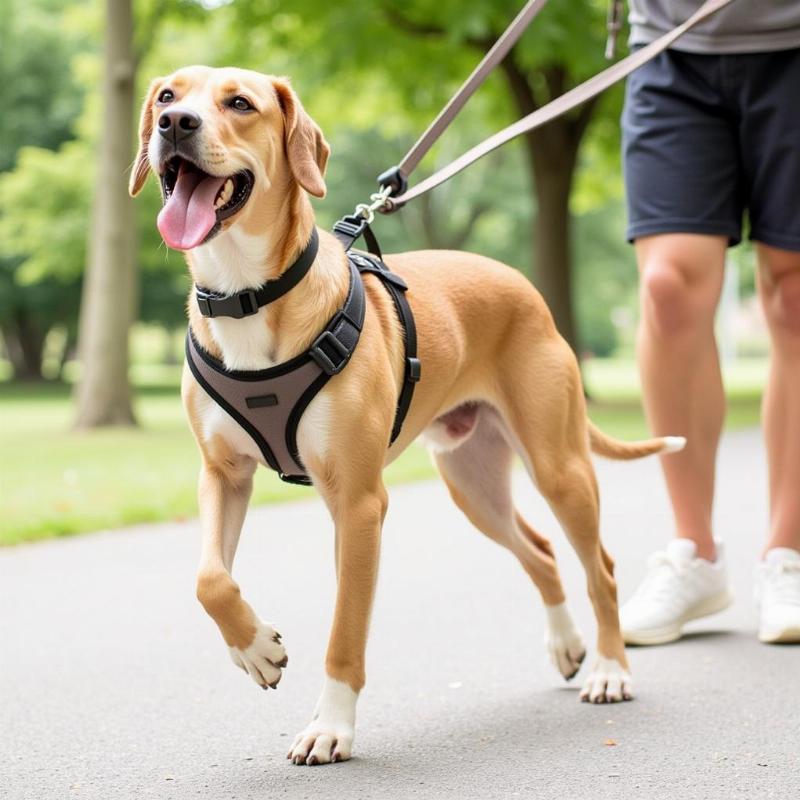Front attachment harnesses are becoming increasingly popular with dog owners in the US, offering a gentle yet effective way to manage pulling and enhance training. Choosing the right harness can significantly improve your dog’s comfort and your control during walks, making outings more enjoyable for both of you. But with so many options available, finding the perfect fit can be overwhelming. This guide will delve into the benefits, considerations, and top picks for front attachment harnesses for dogs, ensuring you have all the information you need to make an informed decision.
Understanding the Benefits of a Front Attachment Harness
Traditional harnesses often attach to the dog’s back, inadvertently encouraging pulling by engaging their natural sledding instinct. Front attachment harnesses, however, clip to the dog’s chest. When your dog pulls, the harness gently steers them back towards you, redirecting their attention and discouraging the pulling behavior. This gentle guidance minimizes pressure on the neck and trachea, making it a safer option, especially for smaller breeds or dogs prone to respiratory issues.
 Dog walking with a front attachment harness
Dog walking with a front attachment harness
Choosing the Right Front Attachment Harness for Your Dog
Selecting the right front attachment harness requires considering several factors: size, breed, activity level, and potential health concerns. Proper fit is crucial for comfort and effectiveness. A harness that’s too loose can chafe or slip off, while one that’s too tight can restrict movement and cause discomfort. Measure your dog’s girth and chest circumference accurately to ensure a snug but comfortable fit.
Size and Fit: The Key to Comfort
Always consult the manufacturer’s sizing chart, as sizes can vary between brands. Look for adjustable straps to fine-tune the fit and ensure optimal comfort. A well-fitted harness should allow for two fingers to fit comfortably between the harness and your dog’s body.
Breed-Specific Considerations
Certain breeds, especially brachycephalic breeds like Bulldogs and Pugs, may require harnesses with wider straps and padding to avoid pressure on their delicate airways. For larger or more muscular breeds, a heavy-duty harness with reinforced stitching may be necessary.
Training with a Front Attachment Harness
A front attachment harness is not a magic solution, but a valuable tool to aid in training. Pair the harness with positive reinforcement techniques, such as rewarding good leash manners with treats and praise, for optimal results. Consistency and patience are key to success.
Addressing Common Concerns
Some dogs may initially resist the front attachment clip, exhibiting behaviors like pawing at the harness or attempting to chew it. Introduce the harness gradually, allowing your dog to acclimate to it through short, positive training sessions. Distract them with treats and praise to create a positive association with the harness.
Top Picks and Recommendations
While individual needs vary, several reputable brands consistently produce high-quality front attachment harnesses. Look for durable materials, secure closures, and comfortable padding. Consider features like reflective strips for visibility during nighttime walks.
Conclusion
A front attachment harness can be a transformative tool for dog owners seeking a humane and effective way to manage pulling and improve leash manners. By carefully considering your dog’s individual needs and selecting a well-fitted harness, you can pave the way for more enjoyable and stress-free walks, strengthening the bond between you and your furry companion. Remember to combine the harness with consistent training and positive reinforcement for optimal results.
FAQs
- How do I introduce my dog to a front attachment harness? Gradually introduce the harness through short, positive training sessions, using treats and praise to create a positive association.
- Are front attachment harnesses suitable for all breeds? Generally yes, but consider breed-specific needs, like wider straps for brachycephalic breeds.
- Can a front attachment harness prevent pulling completely? It’s a training aid, not a guaranteed solution. Combine it with positive reinforcement for best results.
- How do I choose the right size harness for my dog? Measure your dog’s girth and chest circumference and consult the manufacturer’s sizing chart.
- What should I do if my dog chews on the harness? Distract them with treats and praise during training. Consider a chew-resistant harness if the problem persists.
- Can I use a front attachment harness for running with my dog? Yes, many front attachment harnesses are suitable for running. Ensure it fits securely and allows for a full range of motion.
- Are front attachment harnesses better than back attachment harnesses? Front attachment harnesses are generally recommended for managing pulling, while back attachment harnesses may be more suitable for general walking or activities like jogging.
Related Articles on Beautdogs.us
- large dog harness and leash set
- best harness for biking with dog
- saddle bag harness for dogs
- dog basket for bike front
Beautdogs.us is your premier online destination for all things dog-related in the US. We offer expert advice on dog breeds, care, and product recommendations. Whether you’re a seasoned dog owner or just starting your journey, Beautdogs.us provides the reliable, comprehensive, and engaging information you need. For further assistance, reach out to us at [email protected] or call +1 501-555-7529.